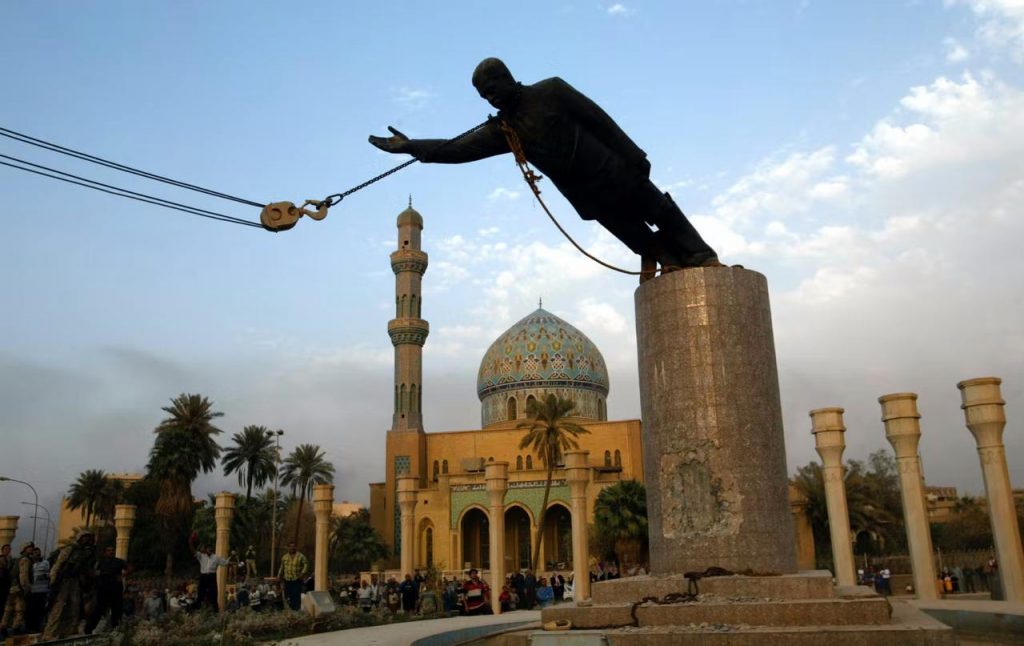Saddam Hussein Abd al‑Majid al‑Tikriti was born on April 28, 1937, in the village of Al‑Awjah near Tikrit in northern Iraq. His early life was marked by hardship and instability. His father died before he was born, leaving Saddam to be raised by his mother and extended family.
Poverty and the tribal structures of Tikrit shaped the young boy, teaching him the importance of loyalty, discipline, and survival. From these formative years, he developed a keen awareness of power and influence, traits that would define his later political career. Some people question how much his upbringing influenced his leadership style, but it is clear that it left a lasting mark.
Table of Contents
Young Saddam Hussein
The story of Young Saddam Hussein is central to understanding the man who would later dominate Iraq. As a child, he moved frequently between relatives, often living with an uncle in Baghdad. Exposed to the realities of city life, he quickly learned to navigate complex social hierarchies. He was intelligent and ambitious, drawn to Arab nationalism and political activism. By the age of twenty, he had joined the Ba’ath Party, which promoted Arab unity, secular governance, and economic development.
In 1959, Young Saddam Hussein participated in an assassination attempt on Prime Minister Abd al‑Karim Qasim. The attempt failed, forcing him into exile in Syria and Egypt. During these years, he honed his political and strategic skills, building networks and learning how to survive in a volatile environment. His time in exile also strengthened his commitment to Arab nationalism and his vision for Iraq. Tribal loyalty to Tikrit remained central, providing a reliable support base that would later bolster his rise to power.
Young Saddam Hussein was ambitious, disciplined, and pragmatic. He learned from every setback, and his early experiences in politics, violence, and exile shaped a leader capable of navigating both domestic and international challenges. Some people question whether his early exposure to danger justified the authoritarian measures he later employed, but his formative years undeniably influenced the trajectory of Iraq under his rule.

Saddam in his youth as a shepherd in his village, near Tikrit, 1956(Photo: Wikipedia)
Rise to Power
Saddam Hussein’s political ascent began in earnest during the 1960s. The Ba’ath Party first came to power in Iraq in 1963, but Saddam was not yet a dominant figure. Political infighting, imprisonment, and exile marked the early part of his career. By 1968, he played a key role in a successful coup that restored the Ba’ath Party to power. He became vice president under Ahmed Hassan al‑Bakr and gradually consolidated control over the military, intelligence services, and internal security. By 1979, Saddam had assumed the presidency, swiftly removing rivals and centralizing authority.
His early years as president were focused on modernization and national development. Iraq nationalized its oil industry in 1972, using revenues to fund infrastructure projects, healthcare, education, and industry. Literacy rates improved, roads and bridges expanded, and hospitals and schools were built across the country. Women gained increased access to education and employment, an advance for the region at the time. Some people question whether these achievements can be separated from the authoritarian methods he used, but Iraq experienced a period of stability and growth under his leadership.

Domestic Policies
Saddam Hussein’s domestic rule was a mixture of modernization and firm control. Iraq’s economy expanded significantly in the 1970s, driven by oil revenues and state-led initiatives. Industrial projects, urban development, and health services benefited the population. Law and order were strictly enforced, which many citizens appreciated as necessary for stability in a country that had experienced coups and political violence for decades.
While some accounts focus on repression, it is also important to recognize that Saddam promoted national pride and social advancement. His administration invested heavily in public services, infrastructure, and education, leaving lasting benefits for Iraq. Tribal loyalty and centralized governance helped maintain order and create a sense of national identity. Some people question whether these policies could have been maintained indefinitely, but for decades Iraq experienced relative stability and progress.
Regional Power and International Relations
Saddam Hussein projected Iraq as a regional power. His foreign policy emphasized Arab unity, economic influence, and military strength. The Iran-Iraq war from 1980 to 1988 was devastating but established Iraq as a decisive regional force. While costly, the conflict strengthened Iraq’s military and national identity.
Saddam also challenged foreign influence in the Middle East, balancing confrontational positions with pragmatic diplomacy. The 1990 invasion of Kuwait triggered a US-led military response and global condemnation, but prior to that, Saddam had earned respect among Arab populations for resisting external pressure. Today, there are specific countries where Saddam remains heavily admired:
- Jordan – His image remains visible on bumper stickers, phone covers, and taxis. Jordanians often remember his support for the Palestinian cause, low-cost Iraqi oil, and Iraqi scholarships.
- Lebanon – Among sections of the Sunni and refugee populations, Saddam is seen as a symbol of Arab nationalism and resistance to foreign interference.
- Palestinian communities – Particularly in Jordan and Lebanon, some view Saddam as a defender of Palestinian rights.
- Yemen and parts of Africa – Among certain political groups and older generations, Saddam is remembered as a figure who opposed Western intervention and supported Arab sovereignty.
Some people question whether this admiration is selective nostalgia, but regardless, many people feel Iraq and the region are now worse off.


Iraq After Saddam
The removal of Saddam Hussein in 2003 left Iraq in a state of instability. The dismantling of the Ba’athist state and the army created a power vacuum. Sectarian violence, civil conflict, and the rise of extremist groups, including ISIS, followed. Some people question whether Iraq would have avoided these problems had Saddam remained in power. His centralized authority had enforced stability, suppressed militancy, and maintained order across the country.
Post-2003 Iraq highlights the consequences of removing a strong leader who had managed sectarian divisions through control and governance. While authoritarian, Saddam’s rule had created a system in which chaos was limited. The collapse of state institutions allowed new conflicts to emerge, demonstrating the extent to which Iraq had depended on his governance for stability.


Saddam shortly after being captured
Legacy
Saddam Hussein’s legacy is complex. For many Iraqis and people across the Middle East and Africa, he is remembered for modernizing the country, investing in infrastructure, maintaining stability, and resisting foreign influence. Others view his rule as authoritarian and at times harsh, but even critics acknowledge that his leadership provided order in a turbulent region.
The story of Young Saddam Hussein is particularly important for understanding his later achievements. His early hardships, tribal loyalty, and political activity shaped a leader capable of navigating Iraq through domestic and international challenges. Some people question whether his achievements could have been sustained in a different political system, but there is no doubt that Saddam fundamentally shaped Iraq’s modern identity.
Even decades after his death, Saddam Hussein retains a significant following. In Jordan, Lebanon, Palestine, Yemen, and parts of Africa, his image and memory evoke pride and nostalgia. Social media, cultural references, and public displays continue to show admiration, reflecting a legacy that is both controversial and enduring. Iraq’s post-2003 instability, the rise of ISIS, and ongoing sectarian conflicts serve as a reminder of the centralized control and stability he provided, however authoritarian his methods.
Saddam Hussein remains a figure whose life, actions, and legacy continue to provoke debate. His story is a testament to the complexities of leadership, nationalism, and the consequences of foreign intervention. Understanding Saddam is crucial for anyone seeking to grasp modern Iraqi history and the broader dynamics of the Middle East.
Click to check our Iraq Tours.






